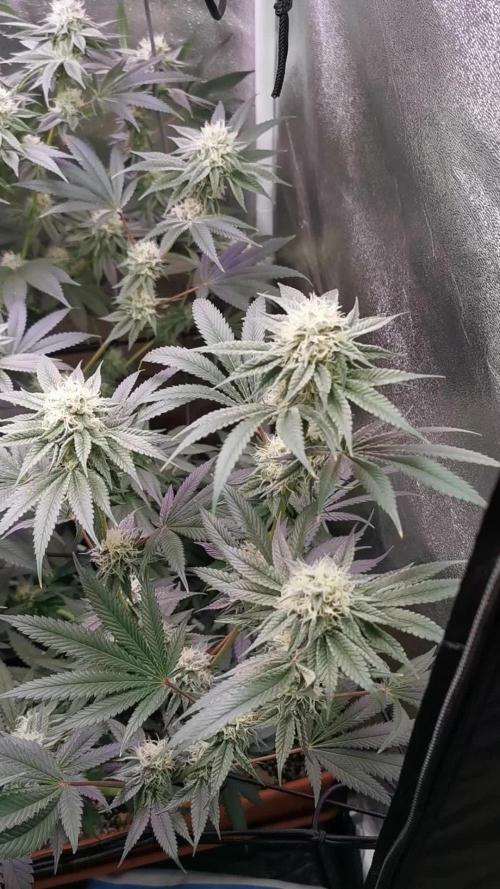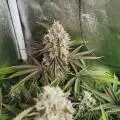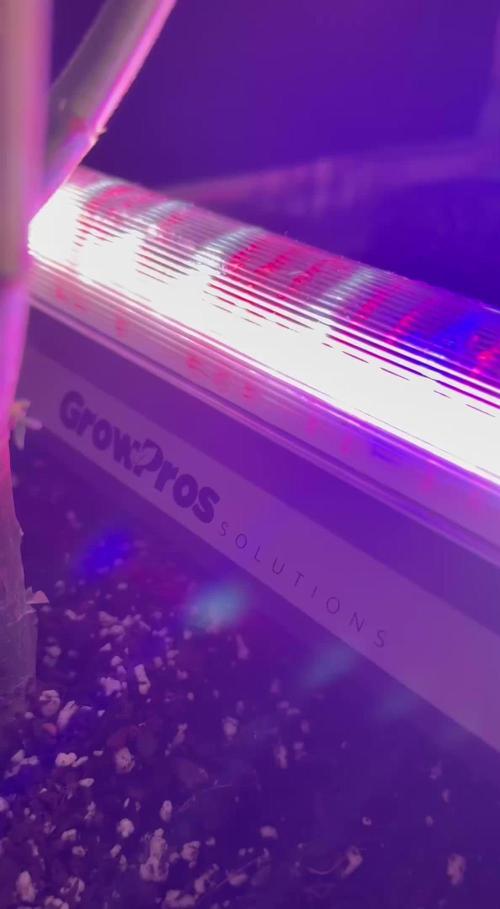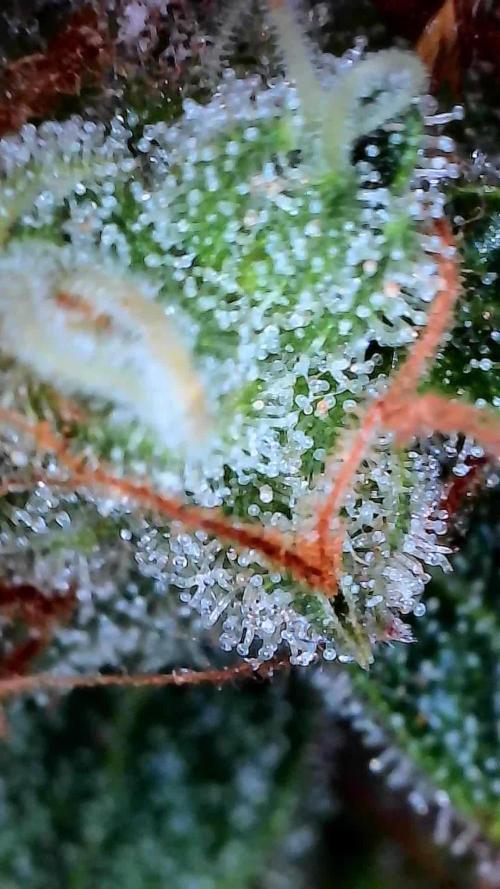The Grow Awards 2026 🏆 



























Likes
14
Share


@BoboLacetti
Follow
After I repotted the plants, they grew really well and healthily for 12 days. Now they are showing iron deficiency again... I already had the problem before repotting. The pH value of the earth has fallen again to 4.8 to 5.7. This time I used biodegradable braids to germinate. I believe that this is the reason for the PH fluctuations in the soil. Every time I water I measure the PH and adjust it to 6 - 6.5. Nevertheless, the PH value drops back to 4 to 5. I'm trying to correct the problem.
I also work with neemoil because I can't get rid of the trips
Processing
Likes
13
Share


@ladyjane
Follow
Gave the ladies their first dose of nutrients. I made sure they were very diluted. they loved it. When I came to check on them, they were all praying. Yay.
Likes
2
Share


@HomeToGrow
Follow
Moin moin,
Die Blüte schreitet voran und viel Arbeit gab es nicht. Die Lemon Zkittle ist riecht top, ist aber winzig und die buds entwickeln sich auch nicht so gut wie erwartet. Die Apples and Bananas hat einen starken Geruch entwickelt den ich aber schwer zu beschrieben finde, als ersten wirkt der Geruch skunkig wird aber schnell von einer süßen leicht erdigen Aroma abgelöst.
Likes
3
Share


@Ninjabuds
Follow
My nine Week 7 flowers are thriving under the new GrowPro Solutions under-canopy lights. The lights have really brought out some amazing colors in the buds. It's so cool to see how much they've changed in just a day! I'm excited to see how they develop even more in the coming weeks.
Likes
33
Share


@burnerac
Follow
Day 78: Nothing to report
Day 79: Nothing to report
Day 80: Added one gallon water with nutrients
Day 81: Nothing to report
Day 82: Nothing to report
Day 83: Nothing to report
Day 84: Nothing to report
Likes
228
Share


@Still_Smoq
Follow
📆 Week 14, Harvest 11-20 January 2024
11 January - I made a determination to cut light power to 25%, and go to a 12/12 schedule, instead of turning light offs for 3 days. After a review of current philosophies and theories - I understand there may be a possibility that coldness, not light, could be more associated with a terpene and cannabinoid boost during this end process. So I will try something new. .
13 January - Harvest Day. When I opened the tent, the smell of fresh berries, sweet, ripe, heavy with a slight scent of pine filled the air. I cut branches and all shade leaves off, without damaging the sticky buds, and hung them to dry. The closet was at a low 35% RH (due to the 0-5 degree F temps outside) and 60 degrees F. It will remain here with circulation for about 5-7 days.
18 January - The buds were small enough and the closet RH staying staying 35%, it was ready to trim and jar up. This wasn’t too bad a process actually. The leaves flaked off prefectly leaving the bud in tact, so most of the trimming was done by hand using my fingertips, not clippers. A delicate process but fast once you get the hang of it. I’ve weighed and jared them up, along with a boveda 62% RH packet #8 in with each. Here they will stay and cure until their peak THC/terpene levels are reached at about 30-40 days, burped daily until a RH of 62% is reached and maintained.
📑 Product Review: Hybrid Indica Dominate
The outcome: 4.2 ounces/119 grams of quality bud in about 90 days. The developer says just under 65 days, this could be done, it would have to be manipulated somewhat. The buds appear large, compact in size, but not so dense, a true bush variety. They are however loaded with trichomes and covered in resin. There is an excessive amount of sugar leaves that make it more challenging for the beginner to know how to care for it in later stages, especially flower. This pheno definately turned purple.
✂️ Harvest on 13 January
🌊 Using reverse osmosis water with EC/TDS at 0
💡 Light power at 25%
That is it for this grow. Thanks for the look, read and stopping by.
Likes
5
Share


@Jays_Not_Here_Man
Follow
#1 Has stretched up and out! If she continues to fatten as tight as the other two, she will probably be the one with the most weight. Her branches are the tallest and reaching up at least 4-6 inches past both her sisters. Her main cola has some light bleaching, nothing I can do about that, we’ll see how she wraps up.
#2 is going to be a producer! She has so many tips and they are all fattening and developing at about the same rate, she is going to be a beast! Her main cola is rock hard. Did a defoliation on her, she is appreciating the extra light penetration 😎💨
#3 is fattening up! She never did stretch, but then again I had her tied and trained pretty far out. She has been thirsty, I have been feeding a dose close to 700 ppm every other feed which has been every 3rd day for her. During the lower feeds, ppm has been around 275. Her tricomes are mostly clear, with some cloudy starting to show. She has the longest to go, but us already dense, and will only get better.
Likes
9
Share


@Silverback_Guerilla
Follow
TUESDAY 9/3:
I almost want to delete this diary..not even worth my time I'm afraid.
She seems to be stuck. Hasn't really recovered from her root problems despite being transplanted into a looser mix with a couple extra gallons of soil. She doesn't look any worse, but she also doesn't look any better, and the calendar tells me that there isn't much time left for things to change....😟
WEDNESDAY:
I was out at the property for awhile today, hosed off the horsies and cleaned their hooves really well. I was there long enough that I was able to move the plants into direct sunshine for an extra couple hours. I fed her with a half-gallon of water including bembe, terpinator, tiger bloom, beastie bloomz, armor si, and big bloom.
THURSDAY, FRIDAY, SATURDAY, SUNDAY:
I was sick as a dog . 2-day stomach virus, followed by an acute pancreatitis attack...
😷
MONDAY:
I gave her about a half-gallon of aquarium water with some bembe, beastie bloomz, and tiger bloom.
Likes
54
Share


@Papablob
Follow
J'ai enfin eu un peut de temp pour lui faire la peau. J'espère que mon remplacent ne vas pas louper le séchage et le debut de l'afinage.. 🤞🙏🖖
Likes
16
Share


@DonKrika
Follow
Small problem with ph this week. I found out that one of the branches was showing problems, I found out that the ph of the water on the drip reservoir was around 6.3, I don't know what happen for the ph to change,, when I fill up the reservoir the ph was around 6.
I turn off the drip system, empty the reservoir and gave ph correct water by hand and that solved the problem.
This was my last week in veg, next week I will switch the lighting to 12-12.
This week I used Kyle Kushman's "Chiropractic" Plant Training Method, and I'm very happy with the result.
This is the tutorial for anyone interested https://www.youtube.com/watch?v=XdfW2p-lHN0&list=WL&index=29&t=1235s
Used Foliar spray this week
DAY 64 - Nutes
PH - 5.97
Solution Temp - 19
PPM-1520
Watering Volume per plant - 4L
DAY 66 - Water
PH - 5.95
Solution Temp - 18
PPM-603
Watering Volume per plant - 4L
DAY 69 - Water
PH - 5.79
Solution Temp - 18
PPM-575
Watering Volume per plant - 4L
Likes
43
Share


@Sabac
Follow
Plantas sanitas 11 semanas.
Se ven bien saludables con flores recinosas
Y grandes.
Likes
42
Share


@MrGrow
Follow
22.11.2021
40 giorni di crescita vegetativa.
Non molto da segnalare di nuovo, se non che le piante stanno crescendo alla grande nonostante i 100w della sf-1000 spiderfarmer che riescono a coprire 1,2 m² di box.
Tra 1 2 settimane max applicherò lo scrog alle piante.
Alla prossima settimana growers ✌️🏻💚
Likes
13
Share


@Irish_Emeralds
Follow
Running smoothly so far... Still
only watering lighting, approx 200ml every 3 days or so.
Using the BioBizz nutes..
The fish mix stinks!
Likes
49
Share


@masterofsmeagol
Follow
8/1 Took another video but didn't upload either videos when I was in town. I'll have to upload later. I have a lot going on and I need to consult my diary more often. The Temps dramatically changed. I watered yesterday just a few that were light but then it poured all night. This morning things looked SUBSTANTIALLY better. I think as long as I can get some sunlight the next few days things will be alright. That streak of weather in the 100s really did a number on me and my plants. Everytime I go they seem to be looking better so I hope that they bounce back and I don't lose anything after all this work. Plants seem "strong" though. They appear very healthy. This just seems like a mistake I made that was substantially worsened by severe thunder storms we weren't supposed to get. If they don't come back before rain I may move the plants that haven't recovered yet inside the barn for the night. It really depends. I want them to dry out. I'm thinking of going and putting a fan in the cage on the smart pots. I just need to keep an eye on them.
UPDATE: I was worriedly watching my plants from the cams and got a message from my father saying my plants were "REALLY DROOPY." I got there and noticed they were WAY worse then earlier and it was sunny and 70's. I got my dude on the phone and sent him several pictures. Luckily I had a second opinion also from my father. A 3cu ft bag of 707 is 22 gallons. These pots were light like that. They just have a seven foot plant in them lol. I'm so happy. I was planning on bringing them Inside tonight in case of ANY rain, luckily I was able to ascertain THE REAL problem, consult my diary and askother growers. Things are looking good. I'm so happy I'm not overwatered.
8/2 Thank the Lord! And my father for his constant vigilance and my commercial buddy for always being there for me. I went over this morning and everything is back up. Plants definitely got stressed though. I think I was OVER and UNDER watering during those days where it was 100 degrees. It'd 68 today. I say this because as soon as I watered the plants they started picking right back up. Luckily I had a dry bag of 707 to pick up and compare with my 20 gallon grow bags and had my father check the weight as well. He's a forester and told me the weight was about tge same. I gave the big blue cheese in the back closer to 2 gallons until I saw some water coming out the bottom. The reason I think I may have overwatered is that the water evaporated as i had watered during the day or at night but not the 10% that they needed. I didn't QUITEgive them all their 10% last time more like I split the difference and did a gallon amd half. Some did get two though. I noticed some light yellowing going up one of the plants that I've watered the most. These plants are transitioning fast to flower. I think I've got the watering schedule down better and that's "don't water them on a schedule". I'll have to individually take note of the plants. Also on that plant and a few others I see minor nute deficiencies so as soon as I can feed I'm going too. I'm going to show my buddy all my info and ask his advice before i take the next step though. I can't believe they made it through this. Talk about anxiety. Wow.
UPDATE: Talked to my commercial buddy. He advised to pick off any of the dead leaves, (which I mostly already have there weren't many) and to wait until next water to feed. He broke it all down in a way i could understand. Then he broke the feeding down further for me so I now know where to start. He did say he thinks my only problem this year will be, "finding a place to store it" lol. I thought he was joking but he went out back and brought out five gallon buckets with screw top lids lol. This back and forth dialogue (with a professional) is seriously lowering my anxiety and giving me confidence that im doing the right thing. Hes never led my wrong and hes always been there. So has my dad. He said to take the old man out for coffee because he saved my ass! I opted for the bottle of whiskey instead. I'll be checking them later. I'm waiting to feed until next watering and I'm waiting to apply BT. I don't want to do anything to a plant that has been that stressed. I'm giving them a few days to chill. Then the twenties will get a quart of grow big, big bloom and calmag and I'll convert that measure to the same amount for the 30's, and 50's. I'm not sure EXACTLY how big that tote is but I think it's closet to 30 than to 40. So I've got a solid plan for the week. I think what I'll be looking to do next is get my supports up. The wind has been crazy but these plants (even when stressed) seemed super strong! Still no fungal stuff knock on wood.
UPDATE: Had to take the car to the mechanic and snag my wheeler to make it home. I sefoliated quite a few bog yellow fan leaves and some smaller leaves down low. Plants went through some stress thats for sure. I HAD to leave my phone with the wife as she had a telehealth appointment so I couldn't take pictures. I wish I could've because things are looking great. I can't wait until things dry out a bit and I can feed! I'm STILL in awe of how my plants look RIGHT NOW and how the looked yesterday. Another buddy said If I didn't see it (and I didnt know you) I wouldn't have believed it was even the same garden! I'll check AGAIN later if my car is ready. I'm anxious to feed and get my supports up. Plants are STRONG though.
8/3 Plants looked great this morning. I did notice what looked like nute deficiencies on the plants I've watered most. After speaking with a few local growers I decided to water. I watered everything a gallon. The containers got more. The 10 got less. Then i mixed up a feeding solution of 1 tsp grow big 2 big bloom and .5 calmag and fed the 20s approx 1.5 pints. A little less for the 10 and a little more for the bigger pots. I'm going to go back over and if I see no negative effects from earlier I'll use the rest of the solution. I'm hoping this was the right decision. It hasn't been enough time but the bags were light. Not SUPER light but last time I waited it didn't work out well for me. Two local growers have told me theyve been watering daily and they have plants in raised beds and right in the ground. I want my watering to be in the morning anyway. Hopefully this works out. I'll update.
UPDATE: Went back over and everything was standing up nice. They loved that water and the small dose of nures hasn't burned them so ill be able to use more next time. I used a Gatorade bottle thats 1.25 pints amd went from there. A total of two gallons was used on the garden. Things look amazing. Things are changing on the daily. I'm losing some leaves now. Well they aren't dropping off but I'm plucking them before they yet that far. I need to water in larger volumes I think. Plants are drying out too quick. Others are saying they are watering much more often as well. It really hasn't been raining and these plants are huge. I have lush green leaves but this transition and the added watering I think has leeched a lot of the nutrients from the soil. Since I have the fox farm that's what I'll be using. I still have a couple leaves that are destroyed by a fourkined plant bug. It's very identifiable so theres another I need to find. Also seeing chunks missing from leaves. I need to up my ipm game. I don't want to do more than one thing at a time though so I know what happened if anything goes wrong. Since i did the nutes today the spraying of BT or captain Jack's I'd going to have to wait. Despite losing these old fan leaves my plants are dense. Defoliating really helped with airflow. I also noticed some chlorosis on a few leaves. That's why I'm going to start doing the 10% minimum. I'm waiting until they are real dry then I'll give everyone (but big blue) their 10%. I got run off from big blue just from like a gallon amd a half today. I hope my 2 minute video uploaded. It says it dis but u bet it didn't. I'm trying again and I'm at 12%. Let's see if my patience lasts. Looks like it doesn't want to upload
8/4 Thunderstorms and heavy rain all night. It's supposed to rain steadily all day. Plants werent drooped or blown around looking or anything after this storm and I only have minimal supports up. I defoliated anything that needed it. Just a few yellow leaves on the bottom interior. More like nitrogen deficiency. I am watering to frequently though. Im noticing some chlorosis (minor) on old far leaves. Could just be that the soil is getting depleted but "if the brown surrounds your plant is drowned" and I noticed a few leaves like that. Just a couple bit i know what to look for. I hate to say it but i think ive almost got things dialed in for this grow. I will need to put up further supports. These are some STRONG plants. I shook them all off today. The seemed to love the nutes. Plants looked way better this morning than I was expecting. I need to up my watering volume to 10% everytime. I DID fine more pillar damage when defoliating and a four lined plant bug mark on the purple punch in the ten.
8/5 It's not raining right now but it Rained all day and night. Plants really seemed to likecthise nutes. I'll up it to a quart next feed. I defoliated what needed it. Found my FIRST totally yellow leaf of the season. Big old interior leaf i must've missed earlier. Smell has greatly increased. Seeing that these plants seem to have no ill effect from all this water I feel more confident about my ability to fully water them their 10%. Especially since they are massive plants. I have one daln near 8ft and it's damn near as wide. Real good airflow. I think this is gonna be my year. I certainly hope so. I need to get rid of that fourlined plant big but more importantly I need to deal with pillars proactively so next nice night I'm going to treat with bt. Super proud of myself so far.
8/6 Didn't rain much yesterday. In fact I stepped out my door and the sun was fully visible and bright while rain poured down around me. It wad a cool experience but the plants dodnt get much for water. I checked the weight this morning (heavy) and shook off the plants and did my normal morning inspection. I news to remove a pallet so I have more room. Plants are really trying to flower. Next week I'm gonna yet them with a stronger dose of nutes. Last year this was about the time I lost my crop. Knock on wood but this is the healthiest crop I've ever had. I MAY apply BT tonight. Haven't decided yet. I'll keep the diary updated.
UPDATE: Went over to check the plants that were WET and HEAVY this MORNING because of the windstorm. If dried the bags out completely. Everything but the 10 was drooping right over like before. Good thing I've got some pretty good intuition. I took two videos. I gave everything their 10% 2 gallons each and for each container plant. Plants were back up by the time I was done adding supports.
8/7 Sunny this morning. Plants looked good. Had to defoliate some dead leaves. I can't believe those grow bags dried out so fast yesterday! Its just the wind was so strong! Plants were right sideways! They got some syrong roots thats for sure. One of them (my canary) seemed light this morning! But we are getting an inch and a half of rain starting tonight into tomorrow so im not watering ANYTHING. I'm not sure what I'm going to do IF anything. I added to my supports. I COULD put EVERYTHING in the barn where we put heavy equipment. I'll probably at least bring a couple inside in case something horrible happens. Things arecreally doing good. Flowering up nice. Found a cicada on one yesterday. First time I've ever seen one. I'll update with what I decide to do.
UPDATE. My canary seems a little light and is losing lots more leaves im not sure if it's because of the transition to flower but I assume that has something to do with it. Plants still have MORE than enough leaves. Found a couple pillars and killed them. Took a video. I have one blueberry cheese that I hope doesn't have a fungal infection as it's losing more leaves. But it takes more water and is greener and fuller up top. I think I'm just worried because of last year. I've done what I can gor the storm so let's see what happens if I NOTICE it get too bad I can bring some indoors.





























